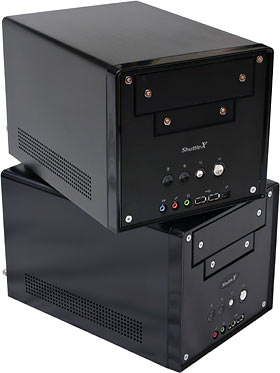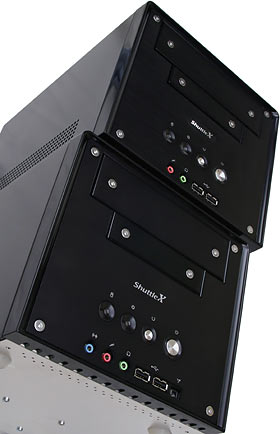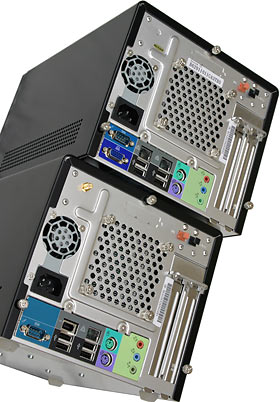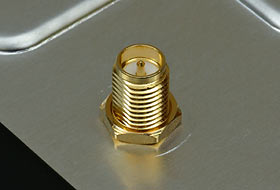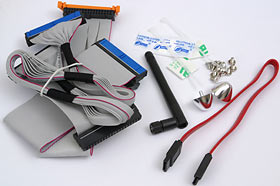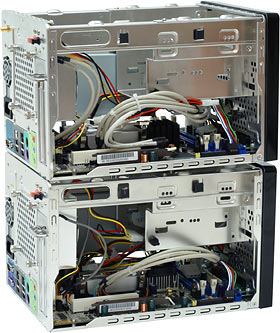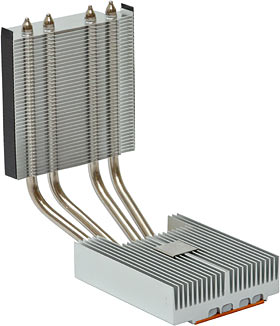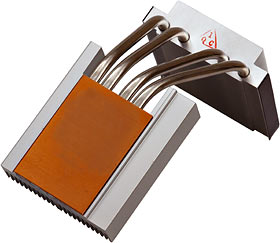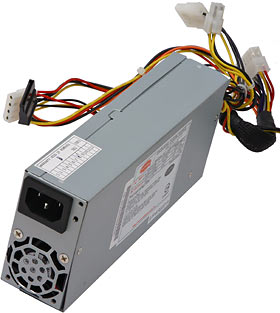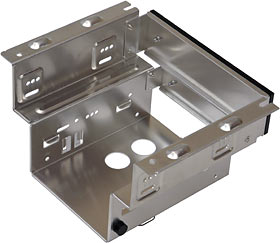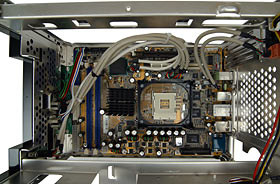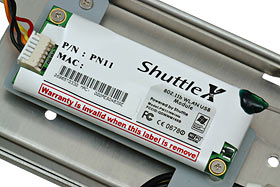
Shuttle SB62G2 and SB65G2 barebones XPCs
Review date: 28 October 2003.
Last modified
03-Dec-2011.
Tiny PCs used to have a bad reputation.
They had far too many custom components (dead power supply? Get a new computer!), they generally had pretty miserable performance (OK for office apps, craptacular for anything else), and their price/performance ratio was ordinary at best.
Then along came the new wave of genuinely high performance, quite reasonably priced mini-PCs, spearheaded by Shuttle.
(Well, OK, maybe spearheaded by someone else, but we're talking x86-compatible, here.)
The Shuttle SV24 came out about two years ago now. It was based on their weeny Socket 370 FV24 PL133 chipset motherboard, which has quite good specifications, even today. Like most tiny-PCs, it has integrated everything - video, audio, LAN, TV out, even FireWire. The SV24 could be configured as a home theatre PC, a thoroughly competent office box, a little network appliance (the single PCI slot could accept a second network adapter) - it could cut it for any everyday PC task, in fact, except 3D games.
That was thanks to the suckalicious 3D performance of the built-in ProSavage graphics adapter. The SV24 had no AGP slot, so there weren't a lot of video upgrade options.
Since then, there've been plenty of small form factor (Shuttle likes to call them "Shuttle Form Factor"...) boxes, and they've settled into two basic categories - ones for gamers that come with an AGP slot and may not have any built-in video capabilities at all, and ones for every-purpose-but-gaming that have integrated video and no AGP slot.
Shuttle's current "XPC" line aims to be all things to all people. If you want to build a high performance tiny-PC - Socket A, Socket 478, even Athlon 64 - they've got a box to suit you. They're not covering the ultra-tiny, super-low-power end of the market - VIA have that stitched up - but if you need anything from Celeron power upwards, they've got it.
The two black boxes in the above picture are the XPC SB65G2 and SB62G2 models - as you may have gathered, Shuttle aren't big on memorable product names. Like the other current XPCs, they also come in silver versions, but we've known for a long time that black is faster. Both colours of enclosure are made from aluminium.
Shuttle use this case design for a lot of their current models; their new Athlon 64 SN85G4 is quite different, but it can be hard to tell the others apart by sight. The XPCs are all 300 by 200 by 185mm (11.8 by 7.9 by 7.3 inches) in size, and weigh a mere 2.85 kilograms (6.3 pounds), plus or minus a few grams here and there, before you add CPU, drives and RAM.
True SFF aficionados can pick the differences, though. The XPC on the top, with only two audio and two USB connectors (USB2.0-capable, naturally) on the front panel, is the SB62G2. It's a specialised XPC whose main claim to fame is that it comes standard with two network adapters.
The one on the bottom, with a third audio connector and a mini-FireWire socket as well, is the SB65G2. It's not quite available yet here in Australia (expect it some time in November), but it's already scored good reviews in countries with more alert local Shuttle distributors, and it has some points that put it clearly ahead of the SB61G2. The 61G2's the single-network-adapter variant of the SB62G2, and was Shuttle's previous flagship Socket 478 XPC.
The basic specs of the SB65G2 and SB62G2 (and SB61G2 as well, for that matter, but I'll get to that later) are very similar. Both use Intel Springdale chipsets - the 865PE variant in the 65G2 and the integrated-graphics 865G in the 62G2. This means that both of them support all Socket 478 P4s and P4-based Celerons. The current Celerons aren't glamorous, but they're excellent value for money, and not slow, by the standards of anyone sane.
The two XPCs each have one 5.25 inch drive bay and two 3.5 inch ones (one 3.5 inch bay is externally accessible), they each have two DDR SDRAM slots for a total of up to 2Gb of memory (and support Dual Channel mode, of course), and neither of them needs special low profile drives or slimline RAM modules.
If you're using Windows XP or later, both XPCs make it possible to connect drives in all six ATA locations - master and slave for both PATA cables, plus one drive for each SATA connector. Where the heck you're going to put all of those drives is left as an exercise for the reader, however, and older Windows versions won't let you do it at all.
For them, you can use the PATA connectors only, or the SATA connectors and one PATA connector, for four drives in total. Or you can disable PATA entirely and use the SATA connectors only, for two drives, which is still likely to be enough.
The SB62G2 even supports RAID, thanks to its ICH5R south bridge chip (versus the plain ICH5 on the SB65; both are standard i865-chipset south bridges). You can only use RAID with the SATA sockets, though, and there are only two of them, and according to the manual you can only use RAID 0, so it's not really very interesting.
Surprisingly enough, you actually can use real RAID on one of these XPCs, though it's unlikely to be worth the effort.
If you don't bother with a 5.25 inch drive, and install 3.5 inch mounting rails in that bay, then you can stick in three hard drives (leaving no room for a floppy) and use software RAID 5, provided of course you've got an operating system that supports that. If you want to use Windows, that means one of the expensive Server variants of Win2000 or XP, not the Home or Pro flavours, and it also means you'll need yet another drive to use as the initial bootstrap system volume - that could be a CompactFlash card with a plug adapter, though.
This all means that three hard drives in an XPC isn't outrageously hard, but three RAIDed drives probably isn't worth the trouble. Either way, you might want to upgrade the main cooling fan (of which more later) if you're using 7200RPM drives, and you definitely don't want to try any of those whizzy new 10,000RPM ATA server drives. But if you want to make a hilariously tiny high reliability 400-plus-gigabyte file server, then yes, it's possible.
Each XPC's Network Adapter Number One is run by a Realtek 8100B chip. The SB62G2's second adapter's powered by an Intel 82562EZ. I think both chipsets ought to work fine under Linux as well as Windows, but I speak as one who has never tried it.
Audio for both XPCs is handled by a C-Media 9739A, which is one of the current collection of surprisingly capable onboard audio solutions. Onboard audio used to be pretty awful, and it's still not the choice of studio professionals, but the 9739A supports 5.1 channel output (four speaker surround plus front-centre and subwoofer), and the usual laundry list of basic 3D sound APIs. OK, maybe it does all that with more CPU assistance than real hardware acceleration, but that doesn't matter much with today's multi-gigahertz processors.
The back panels, again with the SB62G2 on top. There's the 62G2's VGA connector above its serial port, and the 62G2's second network adapter socket is replaced by a rear FireWire port on the 65G2; the 62G2 has no FireWire connectors at all. Apart from that, though, they're almost the same from behind. You get four USB ports, PS/2 mouse and keyboard connectors, three audio sockets (the front audio connectors are pre-plugged into the motherboard, and don't need loopback connection to these sockets), and a pair of optical digital audio connectors - one in, one out.
The optical connectors are right above the two expansion slots, and the slots use a sticky-out external screw fastener system that means you may need to remove the optical connector dust caps, and will very probably need to unplug any optical cables, if you want to get at the card screws. This isn't a big deal, though.
The SB62G2 has no TV or DVI output as standard, but you can add both with an optional PCI card. The SB65G2 can have whatever video inputs and outputs you want, of course; you just have to buy the right graphics card.
Here's the only other back-panel difference. A lot of current XPCs, including the SB62G2, can accept an IEEE 802.11b wireless networking module. Unlike most other XPCs, the SB65G2 comes with that module pre-installed, and its threaded antenna connector sticking out of the back panel.
The antenna comes in the SB65G2's extra-bits box, which also contains one floppy and two parallel ATA cables (one nicely sliced and slimmed, for ease of installation in the cramped case), one Serial ATA cable (just the right length for the little box), two unnecessary but super-shiny spun aluminium feet that you can screw into the box if you want it to look extra-zooty next to your hi-fi equipment, some cable ties and double-sided tape squares, a little bag of thermal grease, and (not shown in this picture) some decent paper documentation and a software CD.
One thing that could be in the extras box, but isn't, is a rear panel bracket for yet another two USB ports. There's an unoccupied two-port USB header on the SB62G2's motherboard, and one port left on the SB65G2 (why only one? Read on).
The six ports already provided on the front and rear panels ought to be enough for pretty much everyone, though, and it's not as if there are a lot of rear expansion slots spare on any XPC for the bracket to fill. Hence, the bracket is an optional extra.
Inside, the two XPCs continue their similarity. The pictures below are all of the SB65G2; apart from the occasional cable and the cooler on the north bridge chip, the SB62G2 looks much the same.
The CPU cooler's possibly the most remarkable single feature of the XPCs. Keeping current Intel and AMD processors cool in a tiny box with restricted ventilation is a considerable problem, and Shuttle have addressed it very well.
With this.
Four heat pipes lead to a rear-mounted radiator that takes care of most of the CPU cooling; fins on top of the CPU block help a little more. The radiator's big enough to accept an 80mm fan, and so it does; there's a medium power Sunon as standard equipment, and you could easily swap it for a more powerful (or LED-lit, or whatever) standard-thickness fan if you wanted.
The downside of this cooling system is that the XPCs aren't any quieter than a regular desktop PC. But you can't have everything.
The base of the cooler is a nice flat copper-slab heat spreader. The whole thing attaches to the CPU via a normal P4 clip arrangement.
This design's neat not only because it can actually handle the heat output of a high-end P4 (plus a margin for overclocking), but because it rolls CPU cooling and case ventilation into one. A great CPU cooler in a badly ventilated case won't be good for much; this kills both birds with one, um, fan.
These two XPCs have the same power supply, a 220 watt Achme unit with world input voltage compatibility, that's cooled by a 40mm fan at each end. These fans are OK at keeping the PSU itself from burning up, but don't come close to providing adequate ventilation for the rest of the case. The CPU fan takes care of that.
Not many computer dealers have these funny little PSUs sitting on the shelf, but SFF machines are now common enough that it's not hard to order a new PSU in if yours goes bang. You can also, in a pinch, use a regular ATX PSU, sitting untidily outside the case with its cables running in through the hole where the original PSU used to be.
There are only so many things you're going to need to power inside an XPC, so you don't get a forest of plugs on the Achme PSU. There are enough, though, to deal with almost every eventuality, including modern high end graphics cards with their own power sockets.
There's one ATX power plug, one ATX12V plug, four large "Molex" drive power plugs, one smaller floppy plug, and one SATA drive power connector.
You can't see the floppy plug and two of the Molexes in the above picture, because an attack of acute laziness prevented me from unhooking that lead from its cable clips around the frame of the XPC.
The single Serial ATA power plug, by the way, is one more than most PSUs provide. Without one of these plugs, you can't use a SATA drive unless you buy a plug adapter, or a drive with a conventional four pin socket on the back as well as (or instead of) its SATA socket.
When SATA drives first started hitting the market, few to none of them came with plug adapters, none of them had four pin sockets, no PSUs had the plugs, and practically no computer stores had the adapters in stock. This was a Bad Scene. Today, you can find adapters easily, but it's still nice not to have to.
The three XPC drive bays are retained with only two screws, and a couple of neat nubs on the chassis rails. The drive cradle is aluminium, like the rest of the chassis members, and is precisely made, with a clear plastic ribbon cable clip underneath it. Cable tidying is particularly important in weeny PCs; every little bit helps when you're trying to haul cooling air through one of these things.
The covers for the two externally accessible bays are screwed in place, partly to minimise rattles (Lian Li make snap-in bay covers that don't buzz, but it ain't easy), and partly for robustness; people tend to carry XPCs around a lot, and prefer the bay covers not to vanish inside if they get thwacked.
The decorative front anodised portions of the bay covers, by the way, are separately retained by hex headed socket screws. This should please case modders, who can do things like mount displays or LEDs or what have you on the back portion, and cut nice clean panel holes out of the front portion.
The miracle of the super-wide-angle-lens makes the XPC interior, sans drive cage, CPU cooler and PSU, look almost spacious.
As with every vaguely tweaky motherboard these days, the XPCs have full fan speed, voltage and temperature monitoring functions. As is normal for i865/i875 boards, they also support configurable thermostatic CPU fan speed control, though you're even more likely to end up running the fan at full speed on these machines than on bigger systems, thanks to the fact that the CPU fan is the main case ventilator.
And they are, of course, jumperless; you configure all of the motherboard settings in the BIOS setup program. The only jumper on the board is the Clear CMOS one, for those painted-into-a-corner moments.
Here's the tiny IEEE 802.11b "PN11 WiFi Dongle", screwed onto the SB65G2's chassis rail. The PN11 is actually a USB adapter, and attaches via a little splitter-daughterboard to the spare USB port header on the 65G2's motherboard. The daughterboard means you can still attach one more USB port, if you like. As mentioned above, though, not many users are likely to need to.
802.11b is yesterday's news in the wireless networking world, with real-world best-case throughput below that of 10BaseT Ethernet, but it's great as long as you don't need to move huge files. It can keep up with all but the most ludicrously fast Internet connections, it's more than fast enough for LAN games, and off-brand access points, adapter cards and high-gain antennas are now very widely available, cheap.
802.11b's even an option if you want to use an SB65G2 (or other, PN11-retrofitted XPC) as a Home Theatre PC and copy huge movie files to and fro without stringing cables under the carpet. Yes, you'll probably be waiting an easy half-hour per CD-sized movie chunk, but if you start copying before dinner, the first chunk will still be ready for viewing over dessert.
What about the SB61G2?
The SB61G2 is what most people will want to buy instead of the 62G2. It's got the same front and rear connectors as the SB65G2, except for the absence of the 802.11b module and the presence of onboard video, and it ain't no slouch.
There's a "20th Anniversary Edition" of the 61G2 as well, with cosmetic enhancements (including a ventilation-improving wire mesh side panel), an ICH5R south bridge (big deal), a slightly beefier PSU, a DVD-ROM drive and memory card reader, and the 802.11b module as standard equipment. And a carry bag!
Like the 62G2, the 61G2 gives you an AGP slot as well as integrated video; like the 62G2, its integrated video is nothing to write home about.
Intel's "Extreme Graphics 2" is about as good as most things that say they take something to the extreme. Like every other vaguely recent video adapter, it gets the job done more than adequately in 2D mode, but in 3D mode it trundles along well behind Nvidia's nForce2 integrated graphics solution, and also well behind every current standalone Nvidia- or ATI-powered graphics card. 3D performance hunters would prefer not to have to pay for it - and for them, the SB65G2 awaits.
What they cost
Here in Australia, Aus PC Market are currently selling the SB61G2 for $AU504.90 including Sydney metropolitan delivery, and the SB62G2 for $AU605 - so prospective SB62G2 buyers might prefer a 61G2 with a PCI network card. The SB65G2 in stock now as well; it's only $AU616.
Aus PC have stock of the Anniversary Edition SB61G2 as well, now; at $AU625.90 including Sydney metro delivery, it's good value.
(And yes, they've got plenty of other Shuttles, too.)
Don't get too excited over these prices, because they're only for the bare-bones systems. You'll need to add a CPU, RAM, drives and an operating system, and a video card too for the graphics-less XPCs.
It's still possible to get away for less than $1100 plus the price of your OS for an SB61G2, though; that buys you 512Mb of RAM, a 120Gb PATA drive and a Celeron CPU, which is more than powerful enough for most purposes.
You can spend a lot more, of course, if you want an XPC with a gigabyte or more RAM, a Radeon 9800 and a high-end P4.
The take-home message is that an XPC system won't cost you significantly more than a regular desktop box. Tiny PCs used to cost more for less expandability; they don't any more.
Overall
Shuttle are far from being the only SFF PC supplier these days. Everybody's getting in on the act.
In no particular order, there's MSI's stereo-ish Mega PC, the new Abit DigiDice, the distinctly different and pretty cheap Insight Solutions MediaBox, Soltek's EQ3702M - and Iwill's got a few offerings too. Including an Athlon 64 version of their tiny ZPC, on the way. And the list goes on.
Shuttle are still the 800 pound gorilla of not-much-more-than-eight-pound PCs, though. You name the x86-compatible socket type, they've got a shoebox computer that uses it.
The SB65G2 isn't quite the top of Shuttle's Socket 478 XPC line any more. Now there's an i875-based SB75G2. The Springdale (865) chipset gives nothing away to Canterwood (875) in real performance, though; Intel's much-ballyhooed i875 Performance Acceleration Technology doesn't do much, and is duplicated by less generically named RAM tweaks on lots of i865 boards. So the only real difference between the two is that the 75G2 has no wireless networking module as standard equipment, but does come with a gigabit Ethernet adapter, one more serial port, and the funky mesh side panel. Whoopee.
The Athlon 64 SN85G4 is the real SFF performance king (this week, at least), but since regular 2GHz A64's (never mind the premium FX-51 variant) sell for more than twice the price of a highly overclockable 2.4GHz 800MHz-FSB P4 - which is already likely to be more than fast enough for anybody who's happy with a single 32 bit x86 processor - they aren't exactly leaping off the shelves. The same goes for Intel's "Extreme Edition" giant-cache rebadged-Xeon Pentium 4s, which are definitely up there with the 64 bit Athlons in the performance stakes - but when you can buy a whole barely-slower computer for the price of the processor alone in a P4EE machine, only those with very unusual financial circumstances are likely to be interested.
The last time I looked at mini-PCs, I was not overly impressed; you could do the same thing for significantly less money, without ending up with an unmanageably big box.
Now, though, I'm a convert; the price difference has shriveled, there's no performance shortfall, most people still don't need anything like as much room as a standard mini-tower case provides... and, let's face it, these little suckers are just cool.
Recommended.
Shuttle's page for the SB65G2
Shuttle's page for the SB62G2
SB65G2 kindly provided by
Shuttle.
SB62G2 kindly provided by Global Business
Technology.
Buy one!
Readers from Australia or New Zealand can purchase various Shuttle XPCs
from Aus PC Market.
Their full range is
here.
(if you're NOT from Australia or New Zealand, Aus
PC Market won't deliver to you. If you're in the USA, try a price search
at
DealTime!)
